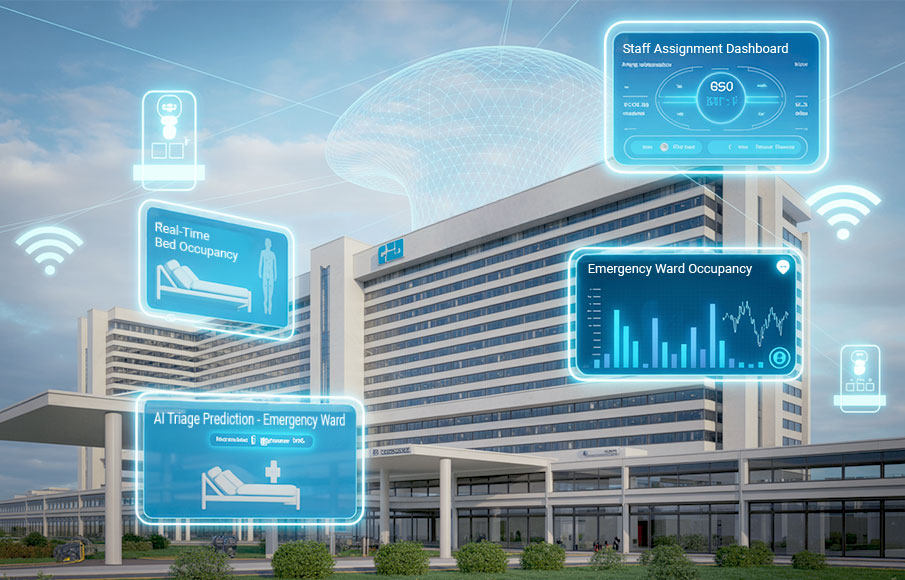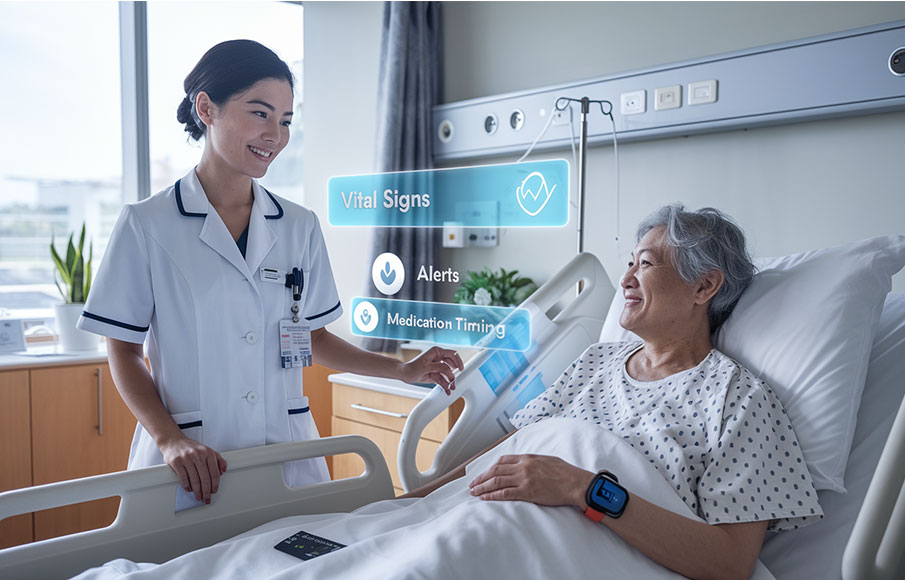The Future of Education: How Technology can help enable Smart Campuses
- 24 June 2022

The education sector has had to face a major shift towards the use of technology to enhance and enrich the learning process. This is in response to the impact of the coronavirus pandemic that forced every institution to review existing processes and make the foray into e-learning and the incorporation of online collaboration tools.
Because of this, the education sector has recorded massive growth and adoption in education technology. According to Grandview, the education technology market was sitting at just $76.4B as of 2019, clearly before the pandemic hit. However, Holon IQ estimates that the market could reach a whopping $404B by 2025.
This has resulted in an increased push for institutions to evolve into smart campuses that go beyond just learning to encompass a seamless, comfortable, and easily navigable academic environment.
Smart campuses will create an education system that incorporates digital technology into the curricula, helping to shape the minds of the younger generation and develop them to become more tech-savvy.
Among many other things, smart campuses will promote:
- Seamless Campus Experience
- Interactive and Engaging Learning Experience
- Improved accessibility to learning & education materials
Therefore embracing education technology is a smart move for schools, polytechnics, colleges, and universities as it is the inevitable future of education. To incorporate education systems into the institution, however, requires the right infrastructure. This article will delve deeper into what are smart campuses and how can they be enabled with the right technology.
What is a Smart Campus and how it is different?

The simple idea behind smart campuses is to improve efficiency, experience, and learning around the institution. A smart campus is an educational environment that is built to enhance and reshape how students learn and what they learn. It improves and simplifies the interaction between students and the institution.
All this is achieved using smart, next-generation technologies. Many of these technologies are AI-driven and Internet-dependent. Among many other things, below are a few ways in which smart campuses make schooling more enjoyable and efficient.
1. Enhanced campus experience
This is inarguably one of the most evident features and benefits of smart campuses. The entire schooling experience is improved in the following ways by simply adopting smart campuses.
- Providing campus mapping technologies: in big academic institutions like the university and polytechnic, where visitors and even new students may need some assistance finding their way around the different lecture halls, parking spaces, faculty buildings, or departments, the campus mapping technology comes in handy.
It saves students and school staff the time it takes to find places and reduces the level of frustration when it comes to navigating to the environment.
- Refining security systems: an academic environment, as with any other environment where people regularly converge, must be well protected. Smart security systems like geofencing, smart locks, and smart ID cards help to provide restrictions and limit access to certain areas within the institution.
- Improving classroom engagement: with the use of engagement platforms like Google Classroom, ClassDojo, Remind, Presence, and many more, engagement within the classroom will be greatly improved.
With all these features and more, smart campuses can make the life of the students and lecturers as straightforward and efficient as possible.
2. Improved Operational Efficiency

Running an educational institution involves countless activities and operations. Many of these operations do not directly deal with academics but form the pillars on which the very functionality and day-to-day running of many schools rest. Here’s how a smart campus improves the efficiency of running the school.
- Smart Parking: Finding a parking space while on campus can prove frustrating for staff, guests, and students. One way that a smart campus can reduce this is to use an application that shows all available parking spaces within the school environment and guide users to the nearest available lot. The result of this is better navigation for the students and staff as well as reduced levels of terrible traffic, road accidents, and fuel consumption.
- Smart Booking Systems: Congestion may occur in certain school facilities such as libraries, laboratories, and lecture halls, especially during peak periods such as exam and project submission deadlines. With a smart booking system in place, both students and staff can get insights as to when the facility is available for use in real time. Enhanced security measures can also be put in place that grants access only to the person or group that booked the facility using a key card or OTP.
In cases where a facility has been booked but the person or group who booked it doesn’t show up within a certain period, the occupancy sensors can detect that the room is not being utilised and release the space for others to book and use. It can also automatically notify technicians to standby for bookings where their support is required such as in the case of accessing lab equipment.
Predictive maintenance: Timely servicing and maintaining of mechanical facilities, laboratories, lecture theatres and classrooms in the schooling environment can reduce time wasted due to technical failures. It also improves manpower and resource utilisation.
With a smart campus, proactive measures can be taken using IoT sensors for data-driven methods to analyse the conditions of equipment regularly to predict when maintenance is needed. This eliminates lights-outs and downtimes and improves reliability, fosters early fault detection, improves performance, reduces maintenance costs and extends the work-life of the equipment.
3. Enhanced Learning Experience

Smart campuses offer innumerable improvements to the process of learning using:
- Cloud-based learning: As the name implies, this form of learning takes place in the cloud, where every student has access to educational material at their fingertips. This could be in the form of online lectures for example when students are unable to attend in person. It can also act as a repository for further learning. Lecturers or even fellow students can upload resources and links for further study and discussion. It can also be a quick and easy platform for the lecturer to provide real-time feedback on projects as well as disseminate graded papers faster.
- Interactive community platforms: With the adoption of a smart campus, students can engage in collaborative learning, where they interact with both educators and fellow students to find answers. This will eventually lead to a society of more self-taught adults, helping to reduce the workload on educators as well as ensuring that they cover more ground in the curriculum.
- Engagement and self-service platforms: The youth like to engage and be engaged in the most seamless ways possible. This fosters a more personalized learning experience where students are charged to enhance the learning process to suit their pace and learning style.
With smart campuses, schools can cut down the need to visit offices and staff in search of answers to inquiries using self-service platforms that allow students to find solutions to immediate, pressing challenges.
- AR and VR technologies: Augmented reality and virtual reality can play a major role in education systems. In the higher education system, students can get hands-on experience and a broader and more detailed understanding of abstract concepts in low-risk virtual spaces.
AR and VR can be used in faculties like medicine, humanities and arts, technical education, STEM courses, and more.
The benefits of smart campuses are innumerable and there is a pressing need to get nations up to speed with the right infrastructure to support the establishment of such institutions.
How Can Schools Get Started with Smart Campuses?

As with building any kind of future-proof structure, creating a campus of the future requires the right infrastructure. Since smart campuses are dependent on the storage, transfer, and transmission of data, below are a few prerequisites to keep the campus running:
1. A Diverse, Secure, and Reliable Internet Connection
One of the most important requirements to successfully build and run a smart campus is a highly reliable Internet connection. A smart campus is the combination of smart technologies with physical infrastructure (It uses internet-connected devices and advanced network infrastructure) to improve the functionality, accessibility, decision making, and sustainability of the school environment.
Network security, reliability, availability, and low latency performance form the groundwork of every smart campus as it promotes and enhances a smoother experience with online, VR and cloud-based learning.
SPTel offers reliable and secure Internet services that enable the education sector to achieve ultra-low latency connectivity for improved application performance across the campus.
2. On-Demand Bandwidth Solutions
SPTel also offers on-demand Bandwidth solutions, allowing you to improve your total cost of ownership for your network by scaling up only when the need arises.
This can be utilised in instances where there is a prominent guest speaker for example who will be live streaming a special lecture. It can also be used to support key projects and sensor development such as CCTV, video analytics, process automation, digital signages, and more. The scalable nature of the solution means that even with the addition of new functions such as VR/AR, cleaning robots and additional sensors can be implemented without having to worry about compromised user experiences. Especially with a more interconnected staff and faculty where self-help, scheduling, or even future interactions within the metaverse could become the norm, the need for scalable bandwidth to cater for unexpected surges will become more important than ever.
With bandwidth on demand, such issues are easily overcome with additional bandwidth provisioned within minutes from a self-service platform.
3. Secure Intranet (Private and Secure Metro Ethernet Connectivity)
For larger campuses such as in the case of universities which can span across a few locations, secure multi-site point to point connectivity is crucial. With SPTel’s Metro Ethernet solution, campuses can benefit from fast and dedicated connectivity within the campus to ensure that shared platforms function reliably without exposing data to external parties. This is especially crucial when it comes to ensure sensitive data such as grades or student thesis are kept confidential.
4. IoT-as-a-Service Platform

IoT devices will play an integral role in ensuring smooth operations within a campus. However, campus requirements are large and diverse and multiple IoT sensors are typically required to bring about a holistic campus solution. These sensors may need to connect with various gateways to successfully communicate information back to the cloud which can increase the hassle of implementation. Beyond this, there is also the concern of data being collected in silos with different sensors having their own data management platform. The onus will then fall on the end user to integrate or consolidate the data for holistic insights which may be a time consuming and cost intensive task. This can result in the delayed and costly implementation of IoT solutions.
That is why it is important to have a solution such as SPTel’s IoT as a Service platform that can help simplify and jumpstart the IoT deployment process.
SPTel’s IoT-a-a-S platform saves you the time and cost of building your own platform from scratch. This ready platform is protocol agnostic which means it can support multiple sensors regardless of their gateway requirements. You can also manage all your IoT devices on this single platform to consolidate data into a central source. Best of all, this one-stop ready solution comes complete with edge computing resources and backhaul connectivity as well for a much faster Go-To-Market (GTM) for IoT deployment. At the same time, you will also benefit from future scalability as the solution allows you to add on more devices as your needs increase.
5. Managed DDOS Protection & Cyber Security

Increased digitalisation also means increased risks of a cyber-attack or some sort of security breach. In a situation where learning materials, exam questions, experiment data, and other more sensitive data like student results are uploaded or shared online, the need to work towards a secure network becomes necessary.
It is paramount to investigate robust security solutions that proactively defend your servers against an attack. This is where SPTel’s clean pipe network and Managed Security solutions can come in to help.
Clean Pipe Network
DDoS attacks can disable connections by flooding the servers with traffic, thereby limiting, or entirely blocking access to these sites. This leads to a massive increase in downtime and can even hinder important tasks such as an online quiz or exam. With SPTel’s clean pipe network, customers will be alerted to such malicious activities as they happen so that proactive preventive action can be taken. Once alerted, customers can choose to mitigate on demand with SPTel’s DDoSProtect solution with mitigation happening within minutes of activation. This reduces the overall impact of the attack and helps in speeding up the recovery of normal operations.
Managed Security
While most educators and campuses are focused on research and student learning, they may not have the resources or manpower to manage their security operations. By choosing SPTel’s managed security solutions, end users can be assured of 24/7 monitoring, detection, and protection of your network.
This means that the school management can greatly reduce the security burden on the institution and focus more on the core academic duties and responsibilities. It also assures you of highly trained experts in the field of cyber-security supporting your institution.
Conclusion
Smart campuses are the way of the future and achievable with the help of the right infrastructure and solutions partner. SPTel is well placed to support such requirements with a reliable, highly secure business class digital network.












